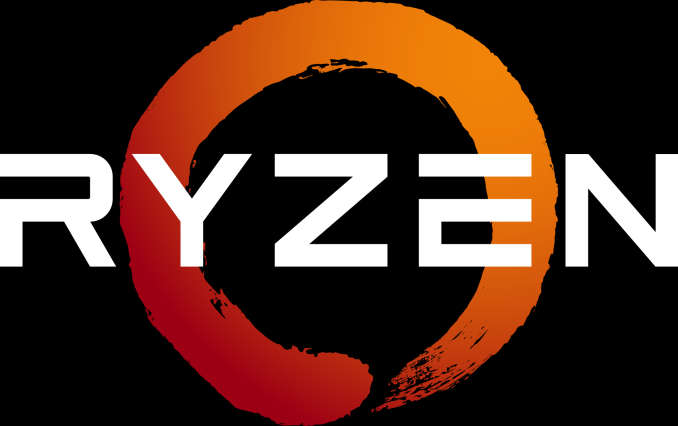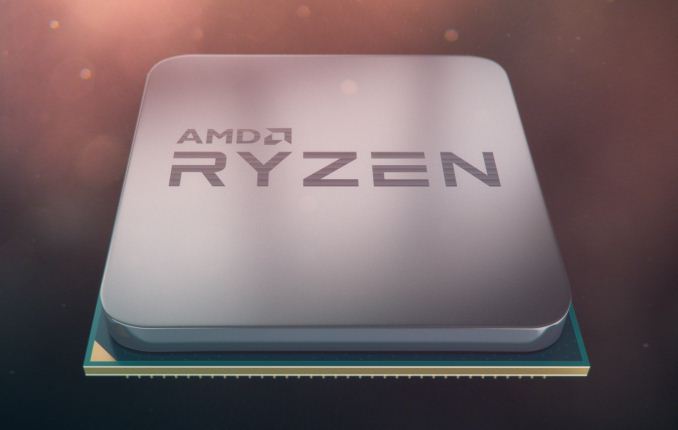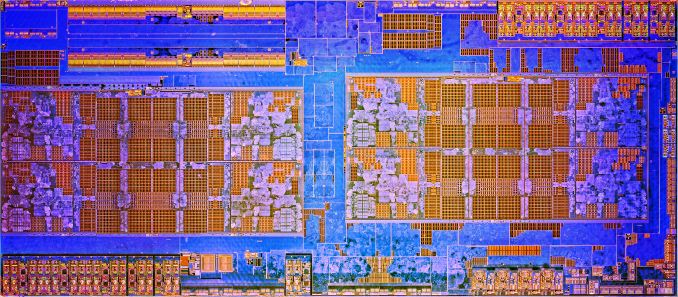AMD Launches Ryzen: 52% More IPC, Eight Cores for Under $330, Pre-order Today, On Sale March 2nd
by Ian Cutress on February 22, 2017 9:00 AM EST
The biggest x86 launch for AMD in five years is today: Ryzen is here. As always before a major launch, AMD gives a ‘Tech Day’ for relevant press and analysts, and through this event AMD’s CEO, Dr. Lisa Su lifted the lid on one of the most anticipated products in the semiconductor industry. AMD knows how to control the level of enthusiasm for its fans, and today is the end result, with processors going on pre-order from major retailers today at 1pm EST, ready for a general hard launch on March 2nd.
In a similar vein to launches of recent smartphones, AMD is doing a staggered announcement/launch with the products on their new microarchitecture. Where Samsung/Apple might give all the details for a product a few weeks before it’s available to buy, today on February 22nd marks the day where AMD is giving consumers information about Ryzen, and specifically the Ryzen 7 family of eight-core products. All the information today is from AMD, and AMD’s internal testing, and pre-orders also start from today for users ready to put down their money for a launch day part. Reviews of the CPUs, as well as when the CPUs will ship to customers, is on March 2nd. This also happens to be right in the middle of two annual shows, Game Developer Conference (GDC) and Mobile World Congress (MWC), making the time between receiving pre-launch samples and being able to provide independent verification of AMD’s performance claims relatively frantic. We’ll do our best!
The Ryzen Family
With a new processor launch, naming the parts and positioning them within the market is critical. So with Ryzen, the processor stack will be split into three based on performance and price: Ryzen 7 at the high end, Ryzen 5 in the middle, and Ryzen 3 for more price-conscious consumers. Both Ryzen 5 and Ryzen 3 are set to be launched later, and Ryzen 7 is the first portion of the family to be released.
Ryzen 7 will have three CPUs to start, all having eight cores and supporting simultaneous multi-threading:
- Ryzen 7 1800X: 8C/16T, 3.6 GHz base, 4.0 GHz turbo, 95W, $499
- Ryzen 7 1700X: 8C/16T, 3.4 GHz base, 3.8 GHz turbo, 95W, $399
- Ryzen 7 1700: 8C/16T, 3.0 GHz base, 3.7 GHz turbo, $329
Ryzen 7 1800X will be the high-end part, featuring a base clock of 3.6 GHz and a turbo of 4.0 GHz, within a TDP of 95W, and for $499. Next to this is Ryzen 7 1700X, launching at $399, with a base/turbo of 3.4/3.8 GHz. The final part for the launch is the Ryzen 7 1700, providing eight cores and sixteen threads for $329 at 3.0/3.7 GHz frequencies.
Processors will initially be available for pre-order from 185 retailers and OEMs worldwide, either as individual parts or pre-built systems.
What, not 40% IPC? 52% IPC??
Enthusiasts and analysts use the term IPC, or ‘Instructions Per Clock’, as a measure of how much the underlying microarchitecture improves from generation to generation. Two decades ago, a good design on a smaller node could net a healthy double-digit gain, whereas in recent years 5-10% gain has become the norm. When AMD initially announced that the new Zen microarchitecture they were developing was aiming for a 40% IPC gain, despite the low IPC they were starting from, users remained skeptical. AMD rehired Jim Keller to work alongside long-term AMD architect Mike Clark and produce a team with several goals in mind: high-performance x86, simultaneous multithreading, and a product to be relevant in the computing, PC, server and mobile space again. So despite this, 40% IPC always seemed a somewhat lofty goal, because Bulldozer was so underwhelming, and despite this low starting point. For the Ryzen launch today, AMD is stating that the final result of that goal is a 52% gain in IPC.
This is something we will need to test in due course!
The Ryzen Silicon, and the Future
AMD pointed out that the new 8-core silicon design runs 4.8 billion transistors and features 200m of wiring. Through previous announcements we’ve examined parts of the microarchitecture including cache sizes, threading, front-end/back-end design, and so on.
AMD Zen Microarchiture Part 2: Extracting Instruction-Level Parallelism
AMD Gives More Zen Details: Ryzen, 3.4 GHz+, NVMe, Neural Net Prediction, & 25 MHz Boost Steps
AMD’s CEO was keen to point out that this is a from-scratch design for AMD, using the knowledge gained from features developed for previous products but ultimately under the hood it looks like ‘a typical x86 high-performance core’, with AMD-specific features and tweaks. We were told that AMD’s roadmap extends into the multi-year range, so while the focus for 2017 will be on this family of products, back at HQ the next two generations are in various stages of development.
BENCHMARKS PLEASE
So despite the 82+ motherboards going to be available, 19 initial PC system builders moving into 200+ through the first half of 2017, the big question on everyone’s lips is how exactly does it perform?
Well, AMD gave us the following numbers:
AMD's benchmarks showed that the top Ryzen 7 1800X, compared to the 8-core Intel Core i7-6900K, both at out-of-the-box frequencies, gives an identical score on the single threaded test and a +9% in the multi-threaded test. AMD put this down to the way their multi-threading works over the Intel design. Also, the fact that the 1800X is half of the price of the i7-6900K.
In a similar vein, again with the Cinebench 15 multi-threaded test, the Ryzen 7 1700X scores over and above the Core i7-6800K (its price competition) and higher than the Core i7-6900K which costs 2.5 times as much.
We’ll tell you what our benchmarks say, with official retail processors. But you will have to wait until March 2nd. Sorry.





















386 Comments
View All Comments
gruffi - Thursday, February 23, 2017 - link
What? AMD lost nothing. They still sell more GPUs than Nvidia. There is more than just enthusiast dGPUs. Btw, Vega architecture is ready to join the Zen party. ;)SolMiester - Friday, February 24, 2017 - link
I have no idea where you got that from, AMD is miles behind NV is GPU sales, they are not even close.Manch - Thursday, February 23, 2017 - link
Intel business practices def had an effect on sales. No doubt about it. Talking about procs designs here. AMD had an absolute hit with their Athlon/64 lines. Problem was Intel responded in kind bc they had to. AMD didn't have an answer that would compete. Top it off their answer came late, underperformed horribly. Shared FP? really? From the get go it was bad. Process technologies no doubt hindered them as well but I don't think it would have helped enough to stay competitive. I'm glad they've come back with performing chip though.mtroute - Friday, February 24, 2017 - link
Well I wish people would clarify exactly WHAT intel business practices they are refering to. Beyond that, the fact that their CEO Sanders was completely incompetent and they were in financial trouble for decades. then they lost the only reason they stayed competitive in the first place, Atiq Raza who left right after the K7 was introduced...Johan Steyn - Thursday, February 23, 2017 - link
Someday Intel will get what they deserve. I remember how I had to buy white box Asus motherboards with zero branding just to be able to get an Athlon motherboard for my customers. Why? Because Intel forced Asus (and everyone else) to not sell AMD boards or loose discounts.People kept on defending Intel. The court found them guilty and got a slap on the wrist. No justice was done. I have zero respect for Intel. What they have done to AMD is unforgivable. They are an evil company.
I was not even allowed to advertise AMD anywhere near to Intel adds if I as a dealer wanted "special" privilege.
I really hope AMD comes back with this. They might have a chance, but the evil is strong with Intel!
rocketbuddha - Friday, February 24, 2017 - link
Despite all the shenanigans that Intel did to AMD, AMD was struck by a thunderbolt with the release of Core 2 Duo. I have seen interviews with the senior management in AMD, dismissing the claim that a x64 processor without IMC would beat a "Hammer" processor with IMC. In addition Intel ditched the "Pentium" branding and went with a new "Core" branding which at that time was strange.Haawser - Wednesday, February 22, 2017 - link
No. Intel simply sabotaged themselves. All the cool stuff that they have actually introduced like AVX2 etc they fuse off on lower tier chips so they can sell the same die for more money. So nobody bothers to use them. If they left the features intact, it wouldn't be a problem. They've shot themselves, basically.vladpetric - Wednesday, February 22, 2017 - link
Almost everyone here is making the mistake that right now AMD would be the main competitor for Intel. Actually, it's ARM. Sure, 10 years ago it was.AMD's main problem was its inability deliver good products on time. There's two factors to this - getting good chip designs, and manufacturing them.
AMD failed on both sides. For the first, it missed production cycles, and production targets. For the second, it never ever matched Intel's manufacturing yields.
Manufacturing chips on 28/22/14/10nm is an incredibly hard problem, and Intel still has the best yields on the planet.
deltaFx2 - Wednesday, February 22, 2017 - link
@vladpetric: Everyone is assuming AMD is the main competitor to Intel because it is. In what market do Intel and ARM vendors compete head-to-head, after Intel has essentially given up on entering the mobile space? None. Intel sells in volume in the desktop, laptop, and server space. The first two are the PC market, which despite decline YoY is still a multi-billion dollar market. And it's unlikely to decline forever unless a worthy successor comes out of the tablet market (it hasn't). There is no ARM design that's even close to matching intel performance in this market. Apple is probably the closest on IPC, but not frequency. The rest aren't even in the ballpark. ARM server is a long way away from being close to a credible threat to x86 in server (in fact, IBM has a better chance). ARM doesn't even have decent hardware except a few niche players in cavium and AMCC.vladpetric - Wednesday, February 22, 2017 - link
@deltaFx2: Intel tried entering the mobile space (phones, tables), and failed spectacularly. They were relegated back to their traditional markets. They did compete with ARM (though not only) and failed.OK, let me refine my statement (which is an opinion) - within the next couple of years the ARM ecosystem is far more likely to steal sales from Intel than AMD. You are correct in that right now there's no direct competition to x86, but things are likely to change. My prediction.
The problem with scaling frequency is energy and heat (the pipelines are generally pretty fast). For Apple's use cases (tablets, phones), energy and heat matter a lot more than the GHz bragging rights.